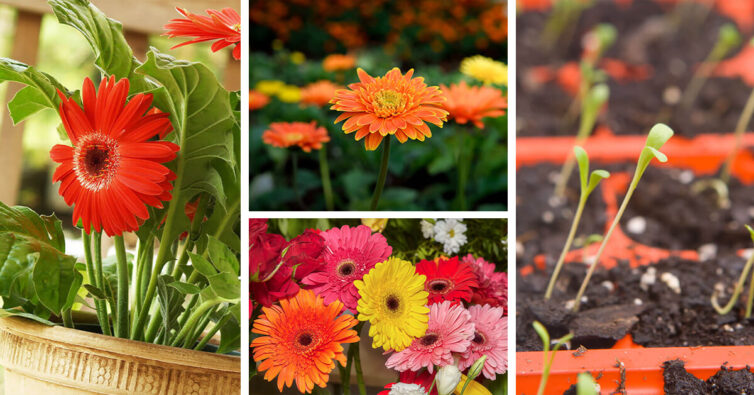If you look in the dictionary under charming, you might well find the Gerbera Daisy. They’re bright, beautiful, and spread smiles. You can use Gerberas on numerous occasions, making them even more endearing.
The Gleeful Gerbera
While you will have little trouble growing outdoor gerbera daisies, be prepared for slow results from your efforts. They can take up to five months to bloom. If you live in USDA growing zones 9-11 you can grow gerberas outdoors all year round. Otherwise, consign them to pots you can bring indoors for wintering.
This is not your everyday daisy. Gerbers have 4-inch blossoms (diameter). The central disk may be bronze, dark, or yellow, the perfect backdrop for lively colors. The most common hues for Gerberas are red, orange, and yellow. Some varieties offer lavender, pink, salmon, and white.
Wait! There’s more. Gerbera Daisies can be single flowers, semi-double flowers, double flowers, and spider flowers. Once you choose your preference, learning how to grow and care for outdoor gerberas is simple.
Spotlight Species: In South America, Asia, and Africa, there are 30 known wild gerbera species. They are native to all three regions, but if the right conditions exist, gerbera can grow elsewhere. The flower got its name from a German Naturalist in the 1700s, Traugott Gerber. Other names for Gerbera daisies are African Daisies and Barberton daisies.
Gerbera Needs for Healthy Growth
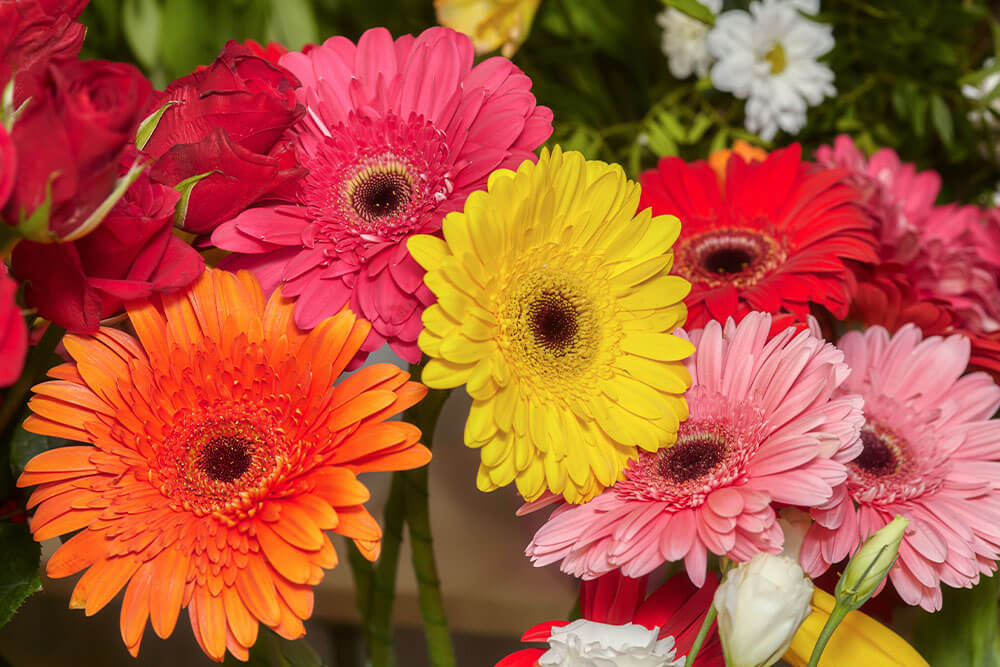
There are 6 things to watch for as you learn to care for gerbera daisies:
- Fertilizer: If you are pot planting outdoors, fertilize your flowers after they reach the bottom of the pot. Seek a 15-16-18 liquid blend. Apply every two weeks thereafter. If your foliage appears to overgrow, there’s too much nitrogen in your fertilizer. Don’t go crazy with fertilizer because your flowers aren’t blooming. They don’t flower continuously but in two-week cycles.
- Humidity: Gerbera Daisies love high humidity combined with warm temperatures. This combination explains the plethora of gerberas in Texas, California, and Florida.
- Light: Gerberas say, “Bring on the sun.” They produce the most flowers when light intensity is high, namely spring and summer. They need six hours of light daily, but make sure they’re not in direct line with the noon-day sun.
- Soil: Place an outdoor gerbera in an area with gritty, sandy soil for best results. You can amend the soil to include these for improved drainage. When the soil soaks too long, the plant may develop crown rot.
- Temperature: Put your gerbera into the ground after the danger of frost passes. Temperatures under 45F don’t bode well for this plant. Once at full height, the ideal temperature range for gerberas is 68-73F.
- Water: Water thoroughly, but let your plant dry down before watering again. So doing so decreases the likelihood of soil-born disease. When it’s time to water, do so early in the morning. Note that while it’s tempting to water your gerbera on hot days, do not do so without checking the soil’s dampness first. If you’re potting outdoor gerberas, they need a little more water at the outset.
Gerbera has the privilege of being the 5th most used flower in the world for arrangements. The others are roses, carnations, tulips, and chrysanthemums. When you harvest the flower, do so first thing in the morning when the stems are plump with water. Cut the ends at a 45-degree angle for longevity. Your arrangement will last 7-10 days.
Gerbera Daisy Care
Initially, check your soil. Without proper, well-drained media, your daisies will probably die. Light is also an issue because they need bright light to blossom, but the sun at the hottest part of the day can damage them. Keep your plants clear of places like concrete or brick, which radiate heat.
You have to wait for spring to grow and tend your daisies. They’ll need a little elbow room (about 14 inches). Make sure the area where the stem meets the soil (the crown) is above the soil. If you put mulch around each plant, it deters weed growth.
Toxicity: While Gerbera Daisies aren’t toxic to pets or people, they can cause stomach trouble if an animal eats some. These are not edible flowers.
Buyer’s Guide to Gerbera Daisies
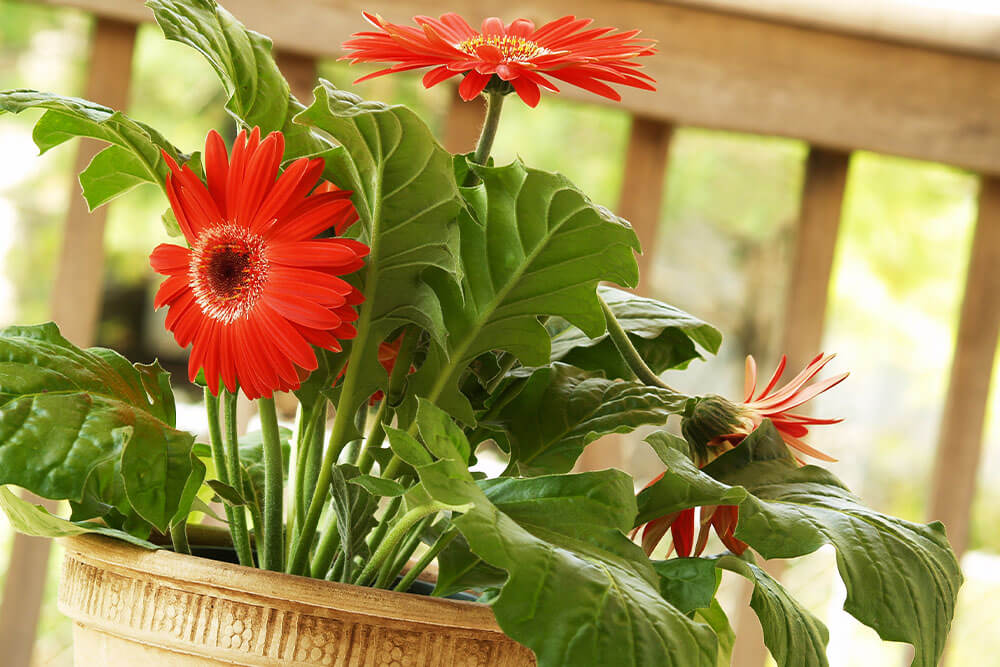
When you go to purchase some gerberas, there are noteworthy things for which to watch. First, look for round flower heads with pristine petals. Choose a plant with straight, long stems. Leaves should present as forest green. Take a moment to look under leaves for signs of pets.
Now, on to what to buy. It’s hard. There are plenty of lovely gerberas. Here are a popular few:
Flori Line Maxi Yellow. This gerbera is truly sunshine yellow. It has 4-inch wide flowers with a height of 12 inches. A hardy producer.
- Jaguar Pink: Also 12 inches tall, the Jaguar Pink, as the name implies, blossoms with posh pink petals. The 3-inch flowers sit on a background of vivid green leaves.
- Karoo: This is an eye-catcher with 5-inch flowers. The blossoms are cream and pink, looking as if an artist painted them. Height at maturity: 18 inches.
- Lisa: On the daintier side, Lisa has 2.5-inch wide flowers. The reddish-purple blossoms are pleasing. This will grow 16 inches tall and has excellent heat tolerance.
- Mega Revolution Orange, Dark Eye: The name says it all! 5-inch wide flowers in bright orange. They grow 8 inches wide and 12 inches tall.
- Sophie: If you want a landscaping plant, Sophie is an ideal choice. It’s not a fussy plant, growing to about a foot tall. The plant features 2.5-inch flowers with red petals and a bright yellow center.
- Sweet Honey: 3.5-inch amber-orange flowers make you think of fall. This gerbera grows to 13 inches tall and is a continuous bloomer.
- Sweet Memories: An outstanding gerbera with semi-double coral-pink blossoms. Mature height: 18 inches.
- Sweet Smile: Wow! Golden-yellow 3.5-inch wide flowers with a backdrop of lime green leaves. It flowers from spring well into autumn with a mature height of 14 inches.
- Sweet Surprise: An easily grown gerbera, producing 3.5-inch lavender to dark purple flowers. Height: 12 inches.
- Volcanos: This gerbera proudly produced 4.5-inch flowers in blazing orange. Mature height 18 inches tall.
This cheerful flower represents purity, cheer, innocence, and beauty. The Victorian Language of Flowers added loyalty to the list, along with the ability to keep a secret.
Celtic tradition claims gerbera daisies lessen anxiety and sadness in daily life. The Egyptian meaning is having a close relationship with nature and devotion to the sun (likely the God RA)
Watering Outdoor Gerbera
In an average season, you will water these pants every three to five days. ONLY water if the top of the soil is dry. When you do water, don’t get droplets on the flowers. When you overwinter the daisies, they won’t need much water at all.
The key is watering extensively because the gerbera roots are deep. The soil must have good drainage to avoid sogginess. Water gerberas first thing in the morning. When Summer comes (85F or higher), move to watering twice a week.
There’s an easy finger test for measuring moisture. You put your finger into the soil. If it’s muddy, hold off. Otherwise, hydrate at the base of their stems.
What the Gerbera Daisy’s Colors Tell Us: If you’re looking to create a meaningful bouquet or bundle, you can use the symbolism of the gerbera’s color as a guide. Pink represents grace, strength, gentility, and admiration. Red gerbera speaks of being surrounded by love. The white gerbera embraces innocence, which is why it may appear as a gift to families with a new child and in wedding bouquets. Finally, yellow is fast friendship and joy. A splendid choice for a birthday arrangement.
Potting and Repotting
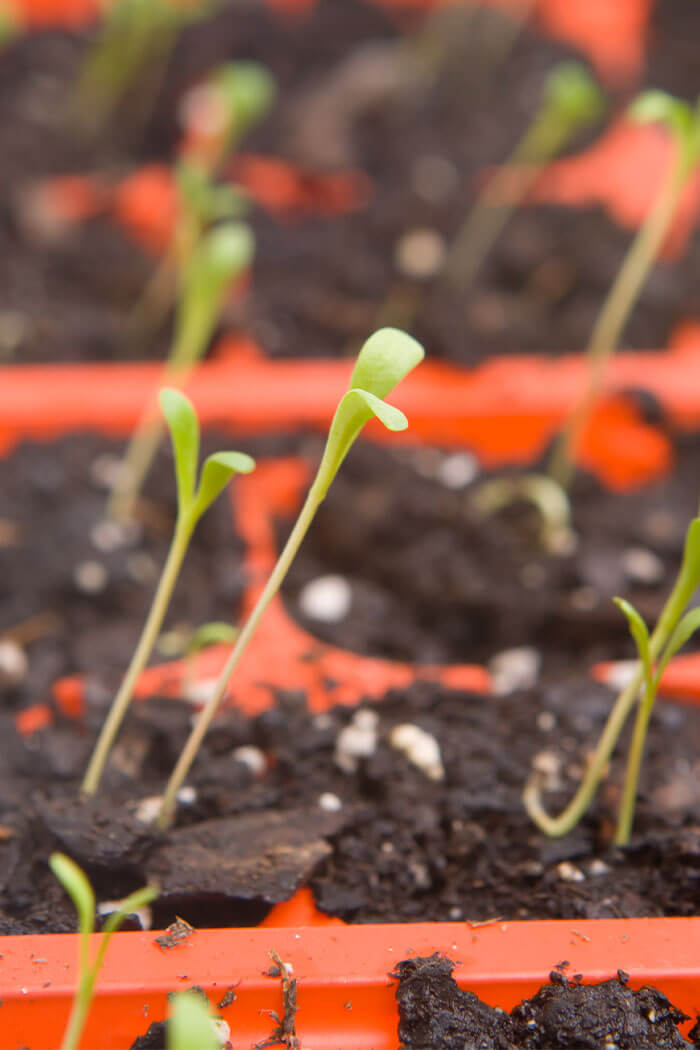
If you are growing your outdoor gerberas in pots or need to move the plant for some reason, take care to be gentle. These plants don’t take well to transplanting. Think ahead. Get a pot about 2” in diameter larger than the present one. Check for several drainage holes.
On average, outdoor container plants require repotting every two years. Before moving, create a healthy soil mix. This is a good time to change the media or amend it.
Placement: Gerbera daisies make an excellent addition to rock gardens, border assortments, and inside your beds. Wherever they grow, they attract hummingbirds, bees, and butterflies.
Pruning and Maintenance for Gerbera Daisies
The time to prune gerbera daisies is after it’s done flowering (late winter is good before new growth begins again). Remove all the dead leaves, flowers, and stems. If there are thin stems, remove them.
Step back. Where are stems too long or misplaced? Start shaping there. When you are content with the results, give the gerbera a good watering. This decreases the chance of plant stress. Also, provide some 10-10-10 fertilizer to the soil around the plant.
Clip a few stems just above the soil level. They should be 6 inches long. If you have rooting hormone, you can apply it now (you will have more success). Mist the clippings and put it in a plastic bag. Leave the bag where it receives indirect sunlight. Mist the inside of the bag daily until the stems root. Now, give them a new home.
Gerbera Daisy Blooming and Resting Periods
If your outdoor gerbera is in a pot, bring it indoors when you know the temperature will dip below 40F. Don’t do this swiftly. Initially, bring it indoors at night, but return it outside by day as long as it’s 60F.
Place the pot near a north-facing window and reduce watering. Your daisy may not bloom during winter. Dormancy is common.
Standard vs. Mini-Sized Gerbera: A standard-sized gerbera bears large flowers, while a miniature gerbera has small blossoms. When we say small, we’re talking about clusters just over 2 inches across. A standard goes far above that, often measuring 4-5 inches in diameter. Extra large Gerberas can grow to 6 glorious inches.
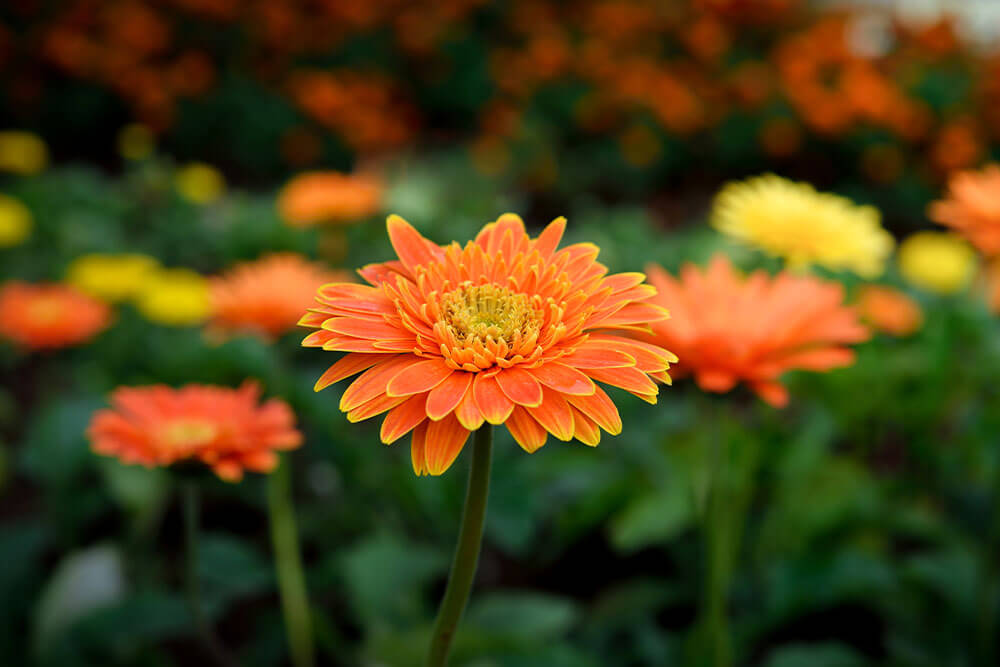
Gerbera Daisies: Pests & Diseases
The most common disease is powdery mildew. You’ll notice whitish spots on the leaf that quickly expand. With time, it turns gray. Powderly mildew impacts leaves in various ways, including curling the leaves and stunting their growth. Eventually, the leaf withers and dies. You will need a fungicide or Neem oil to treat powdery mildew.
Two sap-sucking insects that appear on gerberas are aphids and whiteflies. The leaves will turn yellow. While they eat, whiteflies leave their eggs beneath the leaves. Spider mites appear, too, yellowing the leaves or even killing them. They love hot weather. If you see little web-type structures on your plant, spider mites are the culprits.
There is a legend among the Celts that says God spread these daisies around the world when a child passed away. The idea was to provide a little joy in a time of sadness. The Norse say that the Goddess of love and beauty considered the daisy sacred. Other cultures commonly associate the gerbera with hope, childlike joy, honesty, and optimism.
Troubleshooting Common Gerbera Daisy Problems
- Environmental issues: There are a lot of environmental issues that impact your gerbera health. Poor drainage leads to rot. You’ll notice a sudden drop of leaves. You may be able to save the plant by replanting it in the appropriate soil and letting it dry out thoroughly.
When your gerbera gets leggy and produces a few flowers, it’s not getting enough light. Figure out a better spot or refine the landscaping so it receives more sun. If the weather turns hot and stays that way for a spell, gerberas may stress. Make sure they’re in an area without direct noon-day sun, and keep the soil moist. - Yellowing: Yellowing may imply spider mites. They actually look a bit like spiders and leave behind webbing. Give the plant a good spray to knock them off. Alternatively, a plant with yellow-edged leaves may have a magnesium deficiency. Add an amendment to the soil. Yellow leaves with green veins mean the plant isn’t getting enough iron. A liquid spray is a good option.
- Wilting: Wilting can be a sign of improper watering (over or under). If it happens to be hot and the pant’s soil is dry, give it a good soaking. Observe the amount of light the gerbera receives at noon. You may need to move it closer to indirect lighting.
The color of your gerbera’s flowers has meaning. For example, a yellow blossom acts as a wish for joy and friendship. Here are more.
- Pink: the color of admiration, approval, and inspiration.
- Red: passion and love. Presenting it on Valentine’s Day represented enormous loving feelings toward the recipient.
- Orange: Clarity. Avoid the complex when things are fine as they are. Orange gerberas also emote glowing happiness.
- Purple: Value, being a good role model, spirituality. Stay true to yourself.
- White: virtue and the simple blessings in life.Unity of purpose.
Summary
Gerberas are a fantastic option for your outdoor garden. They fill in awkward spaces with splashes of color and height variance. Keep them in partial light and watch your watering cycle, and you’ll have a very happy plant.

